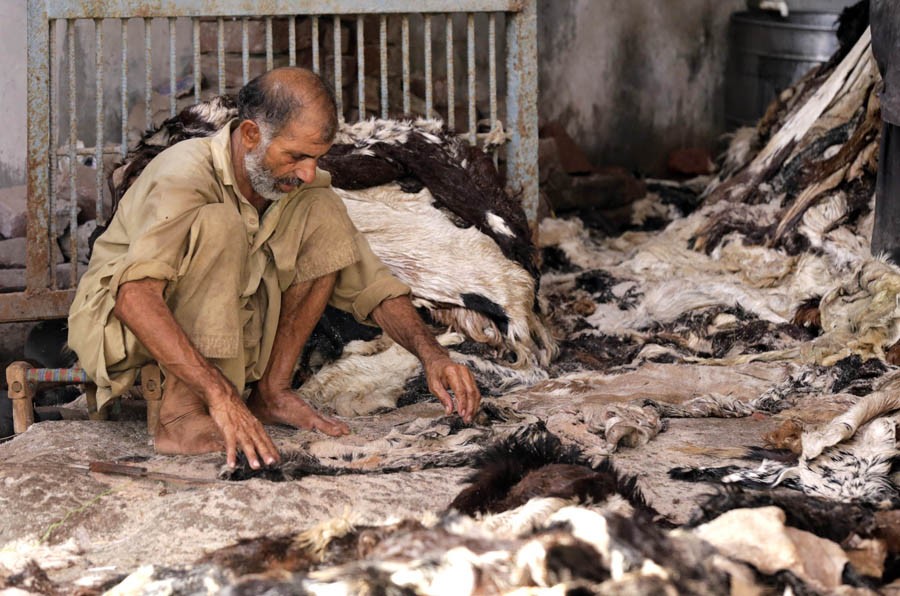
Sacrificial hide did not fetch good returns this Eidul Azha; here is why

This Eid ul Azha was not an occasion for buyers of raw hides to celebrate. The prevailing prices of hides were quite low. A sheep skin sold for Rs30 to Rs50, a goat skin Rs100 to Rs150, and a cow hide for Rs600 to Rs800. There were hardly any buyers for a camel hide.
For the first time in many years, one saw sheep skins thrown on the roadside because buyers were not going door-to-door to collect hides. In some cases, the cost of a house call to collect a hide was more than the price of the hide itself.
The reasons for this steep fall in prices included improper handling of hides, delay in preserving them, presence of unutilised stocks of hides and finished leather stocks, fall in demand for Pakistani leather and leather products, and the failure in capturing new markets.
About a decade ago, a properly removed raw hide would fetch between Rs2,500 and Rs3,000 during eid days. Keeping in view the level of inflation and devaluation of the rupee over the years, the price should have doubled by now.
The case of other animals’ hides was no different. This discouraged charity and welfare organisations who could cover part of their expenses by selling hides to hide merchants. Hides of sacrificial animals are of superior quality as these are healthier and larger in size than those slaughtered during the rest of the year.
Mian Tahir, the procurement head of a leather industry giant, tells TNS that despite repeated instructions by Livestock Departments and players in the leather sector, people do not properly handle animal hides. "One should save a hide from water and sun but people leave them soaked in water right under the sun for hours," he laments. Karachi was even worse in this respect as heavy rains made it difficult to transport hides to the warehouses in time for preservation.
"Many traders avoided procuring hides in large numbers because they could not import enough chemicals for hides’ treatment because of appreciation of dollar against the rupee." In Karachi, the special salt used to preserve raw hides could not be produced in sufficient amount because there was excessive load-shedding during the rains.
While selling and buying of hides was not a roaring business during this Eidul Azha, one must also look at the state of our leather Industry. A large number of tanneries have closed down and the volume of exports is dwindling. The overall exports of finished leather and goods manufactured from this material have come down from $ 948 million in 2017-18 to $ 844 million in 2018-2109, showing a percentage shortfall of 11 percent.
According to data provided by Pakistan Tanners’ Association, leather industry contributes about 4 percent of the export earnings of the country. It is an employment-intensive sector providing jobs to more than one million people, mostly to weaker sections of society through its supply chain. Though the total number of tanneries in the country is estimated to be around 800, representatives of 213 tanneries are registered as PTA members. The leather products produced here include footwear, garments, gloves and products like wallets, belts, and handbags, etc.
In a global market of $120 billion, China earns $10.9 billion annually from leather exports, India $ 3.05 billion and Pakistan $ 948 million. Five years ago in 2013-14, the exports of leather products from Pakistan were worth $ 1.275 billion.
Agha Saiddain, the PTA central President points out that "besides generic issues lack of a level-playing field for Pakistani industry in the region is a major cause for the fall in its leather exports." While other competing industries are facilitated the situation here is otherwise.
Citing some examples, he says they are offered low duty drawback rates on finished leather, made to pay multiple local, provincial and federal taxes, have to face higher tariffs in importing countries due to poorly negotiated free trade agreements and preferential trade agreements with them, face delays in clearance of huge amounts of stuck up sales tax, duty drawbacks, income tax and deferred sales tax claims, increasing labour costs, higher rate of minimum wages and higher input cost on import of tanning chemicals, especially after a drastic appreciation of US dollar against the rupee.
"The government will have to solve these issues in order to give a lease of life to this industry," he adds.
Given the situation, a positive development has taken place earlier this year. Following persuasion by the PTA, Pakistan has signed a trade agreement with Indonesia under which Pakistan’s finished leather will be exempted from customs duty in Indonesia. This will encourage export of finished leather of cow, buffalo and sheep and cow skins from Pakistan to Indonesia.
Dr Asif Sahi, the Breed Improvement director at Punjab Livestock Department highlights another reason for a decrease in demand for Pakistan’s leather products in the global market. "Animal rights movements condemning excessive consumption of meat and products made of animal parts have yielded results. Another reason is the global warming and higher temperatures that reduce the demand for leather garments that are meant to keep one warm."
Syed Shujaat Ali, Pakistan Leather Garments Manufacturers and Exporters Association Chairman, says artificial leather developed by China has affected sales of genuine leather because it is not costly. "If a genuine leather jacket costs $60, the one made of artificial leather will cost $15."
Nevertheless, Ali says Pakistan stands to gain a lot as its share in global leather exports is less than one percent. "Pakistan can increase its percentage share by training its workforce according to the global standards, introducing new technology, supporting the livestock sector, and going for value-added product development."